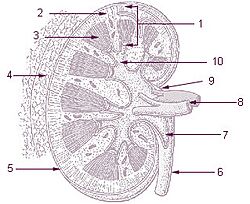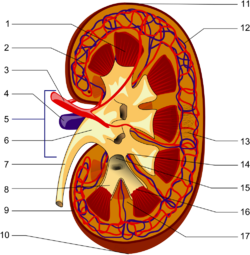Renal medulla facts for kids
Quick facts for kids Renal medulla |
|
|---|---|
 |
|
|
|
| Latin | medulla renalis |
| System | Urinary system |
The renal medulla is the inner part of your kidney. Think of it as the core of this amazing organ. The word "renal" means "about the kidney," and "medulla" comes from a Latin word meaning "marrow" or "middle."
This important part of the kidney is divided into several cone-shaped sections. These sections are called renal pyramids. The renal medulla plays a key role in keeping your body healthy. It helps filter your blood and balance the amount of salt and water in your body.
Inside the renal medulla are tiny structures called nephrons. These nephrons are like tiny factories. They work hard to clean your blood and make urine.
Contents
How the Kidney Works
Your kidneys are like super filters for your blood. They remove waste and extra water. This process helps keep your body's balance just right.
Blood Filtering Process
Blood enters your kidney through a large blood vessel called the renal artery. This artery then branches into smaller and smaller vessels. Eventually, the blood reaches tiny filtering units called glomeruli.
At the glomeruli, the blood is pushed through a special filter. This filter lets small things like water, salts (like sodium and potassium), and sugar pass through. But it stops larger things, like proteins, from getting out.
Water and Salt Balance
After filtering, the liquid (now called filtrate) travels through tiny tubes. These tubes are part of the nephron. One important part is the loop of Henle, which is found in the renal medulla.
The renal medulla has a special environment. It's very salty, which helps pull water out of the filtrate. This process is called reabsorption. It means your body takes back the water it needs.
The cleaned blood then leaves the kidney. The extra water and waste, now called urine, go into collecting tubes. From there, it moves to the renal pelvis and then out of the kidney through the ureter.
Medullary Interstitium
The medullary interstitium is the tissue that surrounds the loop of Henle in the medulla. It's like the space between the tubes. This tissue is very salty.
Its main job is to help your body reabsorb water. Because it's so salty, it pulls water out of the tubes. This helps your body save water and not lose too much in your urine.
Renal Pyramids
| Renal pyramids | |
|---|---|
 |
|
| Latin | pyramides renales |
| System | Urinary system |
Renal pyramids are cone-shaped parts of the kidney. They are named after Marcello Malpighi, a scientist from the 1600s. Humans usually have 10 to 18 of these pyramids in each kidney.
The wide part of each pyramid faces the outer part of the kidney, called the renal cortex. The pointed tip of the pyramid, called the papilla, points inward towards the center of the kidney.
These pyramids look striped because they are made of many straight, parallel tubes. These tubes are parts of the nephrons, like the Loops of Henle and collecting ducts.
Renal Papilla
The renal papilla is the tip of a renal pyramid. It's where the urine that has been made in the medulla finally leaves the pyramid.
From the papilla, the urine empties into a small cup-shaped structure called a minor calyx. This is the first step for urine to leave the kidney and go to the bladder.
Papilla Health
Sometimes, certain chemicals or medicines can harm the renal papillae. This damage can lead to a condition called renal papillary necrosis. It means some cells in this area of the kidney can die.
One common cause of this damage can be certain pain medicines, especially if someone is also dehydrated. Damage to the papilla can also be linked to nephrolithiasis, which is the medical term for kidney stones.
Images for kids
See also
- Medullipin
- Renal sinus
- Medullary interstitium
- Renal capsule







